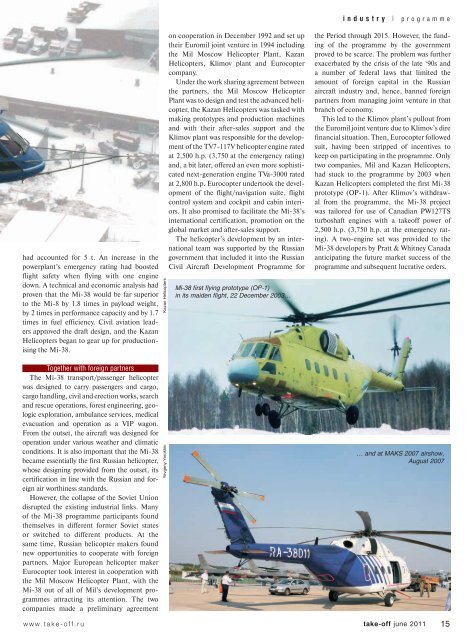SSJ100 launches operations PAK FA two prototypes flying already ...
SSJ100 launches operations PAK FA two prototypes flying already ...
SSJ100 launches operations PAK FA two prototypes flying already ...
You also want an ePaper? Increase the reach of your titles
YUMPU automatically turns print PDFs into web optimized ePapers that Google loves.
had accounted for 5 t. An increase in the<br />
powerplant’s emergency rating had boosted<br />
flight safety when <strong>flying</strong> with one engine<br />
down. A technical and economic analysis had<br />
proven that the Mi-38 would be far superior<br />
to the Mi-8 by 1.8 times in payload weight,<br />
by 2 times in performance capacity and by 1.7<br />
times in fuel efficiency. Civil aviation leaders<br />
approved the draft design, and the Kazan<br />
Helicopters began to gear up for productionising<br />
the Mi-38.<br />
Together with foreign partners<br />
The Mi-38 transport/passenger helicopter<br />
was designed to carry passengers and cargo,<br />
cargo handling, civil and erection works, search<br />
and rescue <strong>operations</strong>, forest engineering, geologic<br />
exploration, ambulance services, medical<br />
evacuation and operation as a VIP wagon.<br />
From the outset, the aircraft was designed for<br />
operation under various weather and climatic<br />
conditions. It is also important that the Mi-38<br />
became essentially the first Russian helicopter,<br />
whose designing provided from the outset, its<br />
certification in line with the Russian and foreign<br />
air worthiness standards.<br />
However, the collapse of the Soviet Union<br />
disrupted the existing industrial links. Many<br />
of the Mi-38 programme participants found<br />
themselves in different former Soviet states<br />
or switched to different products. At the<br />
same time, Russian helicopter makers found<br />
new opportunities to cooperate with foreign<br />
partners. Major European helicopter maker<br />
Eurocopter took interest in cooperation with<br />
the Mil Moscow Helicopter Plant, with the<br />
Mi-38 out of all of Mil’s development programmes<br />
attracting its attention. The <strong>two</strong><br />
companies made a preliminary agreement<br />
Kazan Helicopters<br />
Yevgeny Yerokhin<br />
on cooperation in December 1992 and set up<br />
their Euromil joint venture in 1994 including<br />
the Mil Moscow Helicopter Plant, Kazan<br />
Helicopters, Klimov plant and Eurocopter<br />
company.<br />
Under the work sharing agreement between<br />
the partners, the Mil Moscow Helicopter<br />
Plant was to design and test the advanced helicopter,<br />
the Kazan Helicopters was tasked with<br />
making <strong>prototypes</strong> and production machines<br />
and with their after-sales support and the<br />
Klimov plant was responsible for the development<br />
of the TV7-117V helicopter engine rated<br />
at 2,500 h.p. (3,750 at the emergency rating)<br />
and, a bit later, offered an even more sophisticated<br />
next-generation engine TVa-3000 rated<br />
at 2,800 h.p. Eurocopter undertook the development<br />
of the flight/navigation suite, flight<br />
control system and cockpit and cabin interiors.<br />
It also promised to facilitate the Mi-38’s<br />
international certification, promotion on the<br />
global market and after-sales support.<br />
The helicopter’s development by an international<br />
team was supported by the Russian<br />
government that included it into the Russian<br />
Civil Aircraft Development Programme for<br />
Mi-38 first <strong>flying</strong> prototype (OP-1)<br />
in its maiden flight, 22 December 2003…<br />
industry | programme<br />
the Period through 2015. However, the funding<br />
of the programme by the government<br />
proved to be scarce. The problem was further<br />
exacerbated by the crisis of the late ‘90s and<br />
a number of federal laws that limited the<br />
amount of foreign capital in the Russian<br />
aircraft industry and, hence, banned foreign<br />
partners from managing joint venture in that<br />
branch of economy.<br />
This led to the Klimov plant’s pullout from<br />
the Euromil joint venture due to Klimov’s dire<br />
financial situation. Then, Eurocopter followed<br />
suit, having been stripped of incentives to<br />
keep on participating in the programme. Only<br />
<strong>two</strong> companies, Mil and Kazan Helicopters,<br />
had stuck to the programme by 2003 when<br />
Kazan Helicopters completed the first Mi-38<br />
prototype (OP-1). After Klimov’s withdrawal<br />
from the programme, the Mi-38 project<br />
was tailored for use of Canadian PW127TS<br />
turboshaft engines with a takeoff power of<br />
2,500 h.p. (3,750 h.p. at the emergency rating).<br />
A <strong>two</strong>-engine set was provided to the<br />
Mi-38 developers by Pratt & Whitney Canada<br />
anticipating the future market success of the<br />
programme and subsequent lucrative orders.<br />
… and at MAKS 2007 airshow,<br />
August 2007<br />
www.take-off.ru take-off june 2011<br />
15




